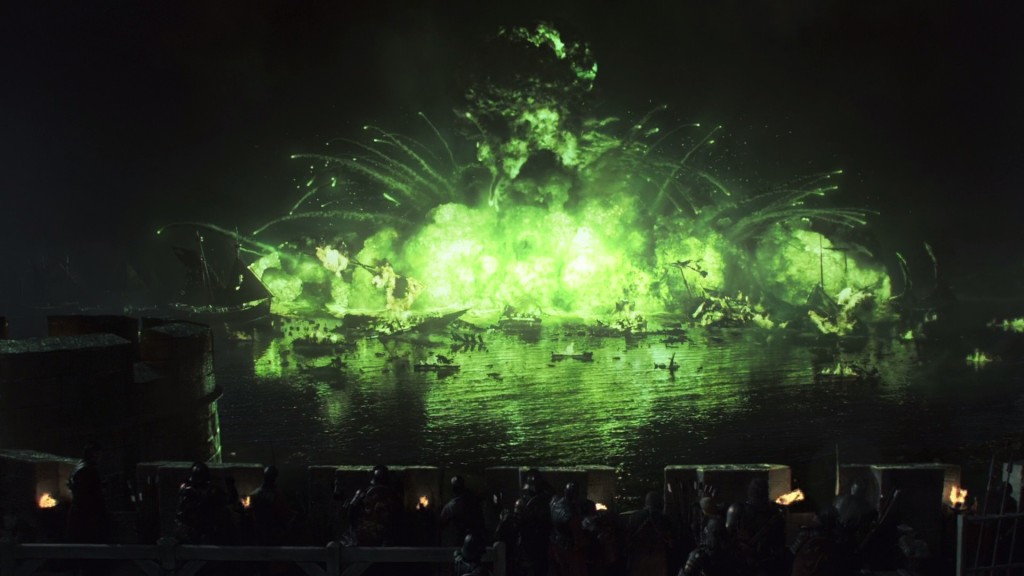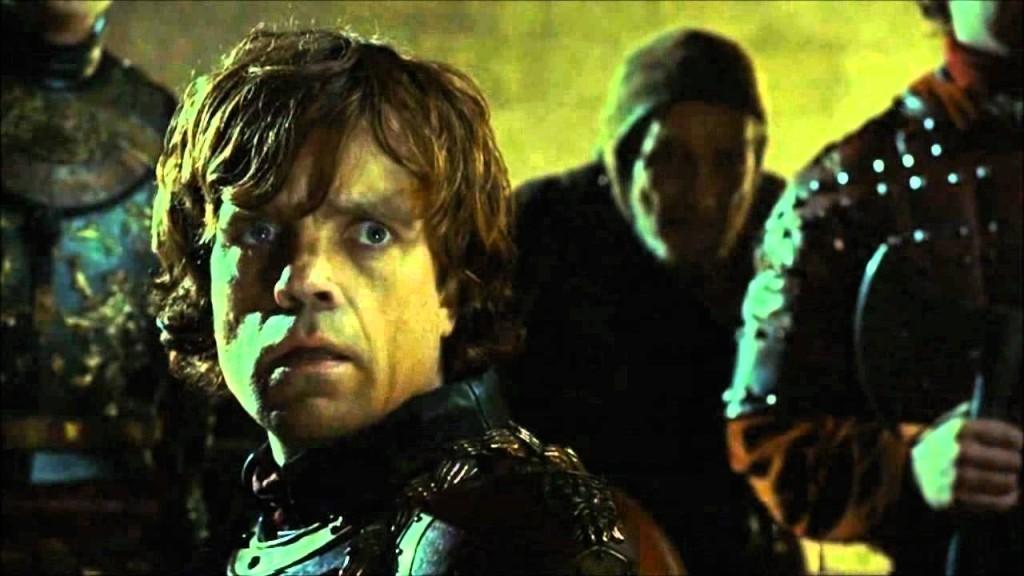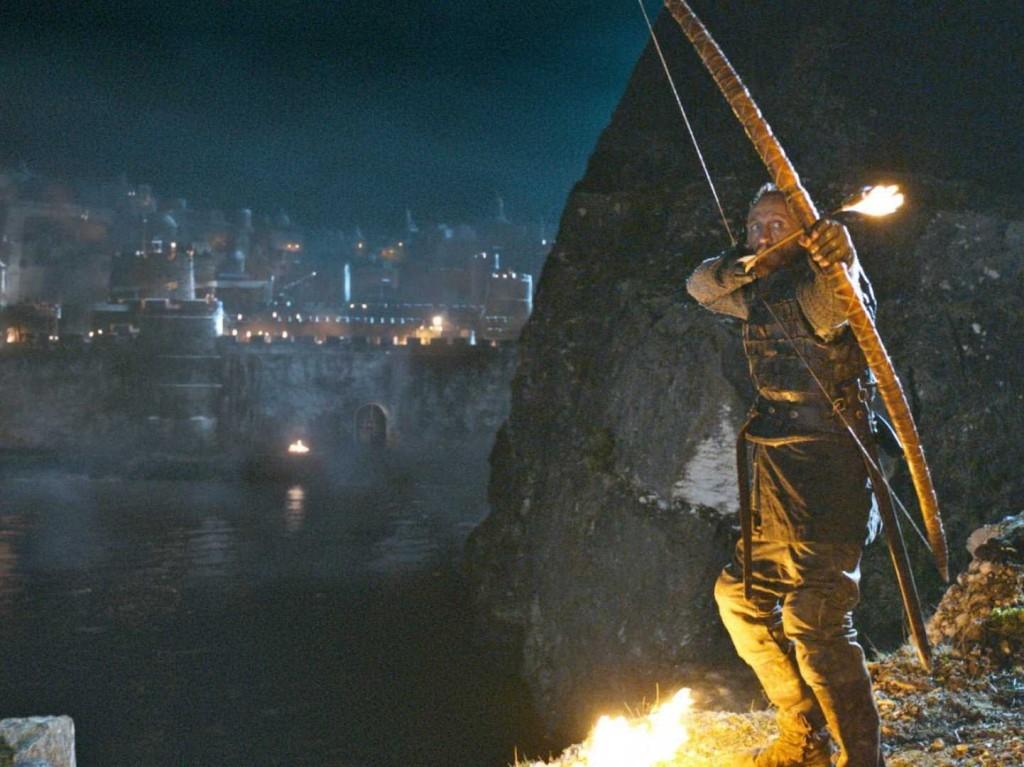HBO’s Game of Thrones brandishes a consistent and high degree of fidelity to the nearly 5,000-page-long source material of George R.R. Martin’s A Song of Ice and Fire novels, but there still, of course, are differences. While most of these gaps from the page to the screen are small and detail-oriented, it is nonetheless the case that the most subtle discrepancies often hold the biggest insight into the adaptation process, into the demands of filmmaking, and into the rigors of the literary narrative.
This, then, is the anatomy of a key scene of Thrones – not because of its dramatic importance or visual effects whizbangery, but because of the telling nature of its realization.
Episode: “Blackwater” (209)
Scene: Wildfire ambush
The Battle of the Blackwater may not have been the first big battle scene shown in the books – there is one witnessed firsthand at the end of A Game of Thrones, and two more fought “off-screen” – but it is easily the most involved, sprawling, and dramatic conflict yet encountered in all five published novels, occupying water and land, castle battlements and makeshift bridges comprised of devastated ship hulls. In the book, it takes six chapters to unfold; in the series, it consumes this week’s entire episode (the first time a single story thread is allowed such a luxury).
Given such epic proportions, it’s unsurprising that HBO had to pony up a significant chunk of change above and beyond the normal – and quite formidable – cost of the episode. It’s even less surprising that showrunners David Benioff and Dan Weiss, who had to practically beg and plead for the extra allotment of resources, had to make a series of hard choices on what to include (the naval portion of the conflict was a must, no matter the cost, despite some pressures to make it all a land battle) and what to cut (most of King Stannis’s fleet, and all of King Joffrey’s).
The single most critical element was, by far, the wildfire trap that Tyrion Lannister unleashes on the elder Baratheon’s warships, even though this itself was transmuted in the adaptation process; in A Clash of Kings, it is Tyrion’s idea all along, struck upon not long after first arriving in King’s Landing to become the acting Hand of the King. (That it became Queen Regent Cersei’s pet project in the show is perhaps something of an effort to simultaneously play up the otherwise [comparatively] sedate monarch’s deviousness, on the one hand, while playing down the Imp’s malicious cunningness, on the other – without the mitigating element of inner monologues, after all, it can be quite hard to contextualize the three-dimensionality of characters, particularly George R.R. Martin’s.)
Although the main delivery method is still wildfire-soaked derelict ships listing in the river – which go unnoticed amongst Joffrey’s Royal Fleet, which itself is needed to draw Stannis and his men into the Blackwater in the first place – there is still extra jars of the substance which come raining down from the scorpions and trebuchets that the Lannisters employ, and there is even an extra dimension of strategy in the form of a giant iron chain that is raised once nearly all of the rebel fleet has entered the river, trapping them in the waters in front of the city and ensuring that they all burn. (On the page, it is Bronn the sellsword who is in charge of raising this makeshift boundary; on the screen, it is Bronn, the Commander of the City Watch, who ignites the wildfire ambush.)
There are a fair number of other deviations, as well. Before the 50-foot explosion of green flames erupts across the Blackwater, destroying all in its path, Ser Davos Seaworth – who is merely the captain of a single ship in the second line, as opposed to the Lord Admiral of the entire fleet – rams ships, engages in swashbuckling raids on enemy decks, and attempts to keep track of his two other sons, who captain their own vessels, as well as his king, who is with his host on the southern shore, waiting to cross the river to lay siege to King’s Landing.
Stripping all this out of the series does surprisingly little to dilute the Battle of the Blackwater’s intent or, more importantly, to undermine its effect. While nearly the entirety of the underlying strategy is absent – a more-or-less constant for the overall season’s King’s Landing narrative, actually – the raw power of the sequence is preserved and, perhaps, even heightened; the screaming of burning and drowning men may be lifted directly from the book, but it is even more heart-wrenching and jaw-dropping when realized in front of one’s eyes rather than described on the page (which is the same for Jack Gleeson’s gleeful response to the carnage in front of his eyes. King Joffrey was never so easy to hate – or to understand on a purely visceral level). And the swirling wildfire, both practical and computer-generated, is literally an awe-inspiring image, even for audiences (particularly on HBO) that are inundated with vivid scenes of carnage.
Indeed, revisions or no, this may very well be the single most effective translation from page to screen thus far. It’s certainly the best episode yet.
Previous installments
“What Is Dead May Never Die” (203)
“Unbowed, Unbent, Unbroken” (506)
“Mother’s Mercy” (Bonus) (510)
The post Anatomy of a Throne: “Blackwater” appeared first on Watchers on the Wall.
Via http://watchersonthewall.com



No comments:
Post a Comment